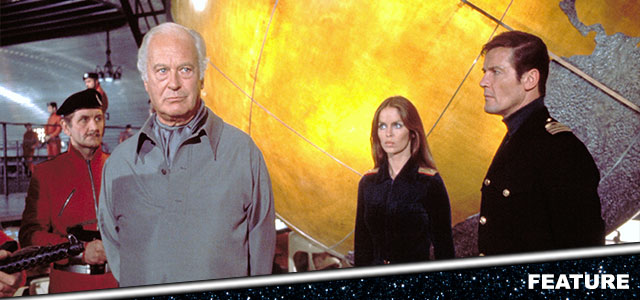
The 25th James Bond movie No Time To Die arrives in Cineworld in September, and we're counting down the days by revisiting all the 007 movies in chronological order of release.
In honour of Daniel Craig's swansong as 007, we're taking a nostalgic trip back through time. This week: Roger Moore stars in The Spy Who Loved Me...
What is the story of The Spy Who Loved Me?
A British submarine carrying six nuclear missiles has disappeared without a trace, along with its Soviet counterpart. At the same time, the British secret service and Royal Navy are sent a copy of a microfilm that outlines the movement of British subs throughout the world. It becomes clear that someone is intending to sell this information to the highest bidder, all the while as a mysterious individual looks to instigate a war between Britain and Russia.
The culprit is rich industrialist Carl Stromberg (Curd Jurgens), who operates from his secret base, Atlantis. He wants civilisation to destroy itself so he can begin a brand new colony beneath the sea. MI6 agent James Bond/007 (Roger Moore) is dispatched to stop him along with Soviet operative Anya Amasova/XXX (Barbara Bach). They have to contend with Stromberg's heavy Jaws (Richard Kiel) along the way, who has been sent to retrieve the original microfilm. Their journey takes them from Egypt to the coast of Sardinia, and there's a twist: 007 killed XXX's lover while fleeing a mission in Austria.
How did The Spy Who Loved Me get made?
The James Bond franchise was in serious need of a refresh by the middle of the 1970s. The combination of an underperforming, critically derided adventure (The Man with the Golden Gun), plus a changing pop culture landscape, had made for a bumpy start to Roger Moore's 007. Although he began with the commercial hit Live and Let Die, it was becoming clear that the campy humour, a substitute for the relatively tough-minded Sean Connery era, was wearing thin, and fast.
Although this tongue-in-cheek approach was fundamental to Moore's portrayal (designed to distinguish him from Connery), it was clear the laughs needed to be bolted to a more robust story, one that displayed the kind of sweeping production values familiar from the early Bond movies. The world of cinema had also changed dramatically at the start of the 1970s: Live and Let Die and The Man with the Golden Gun were clear responses to blaxploitation and kung-fu movies, respectively. And by the time The Spy Who Loved Me arrived in 1977, the movies were about to get an injection of something called Star Wars.
Combine all this with the departure of Bond producer Harry Saltzman, and it was clear the franchise needed to return to its roots. Now flying solo, producer Albert R. 'Cubby' Broccoli planned a grandiose adventure that fused Moore's witty approach with a proper sense of exotic globe-trotting and memorable action sequences. As if to wash the sour taste of Golden Gun from people's mouths, he also initiated the construction of the famed '007 Stage' at Pinewood Studios in the UK; although the studio had long been used throughout the Bond franchise, this is where the space would become synonymous with the series.
Conceived by veteran Bond production designer Ken Adam, the original '007 Stage' (which was later rebuilt twice following fires in 1984 and 2006) was intended to reflect the interior of the Liparus tanker. This is the craft used by the villainous Stromberg to devour entire submarines, a suitably outlandish Bond conceit that required Adams, Broccoli and the rest of the crew to expand their imaginations.
Constructed in 1976 at a cost of $1.8 million, the stage re-set the standard for opulence in the Bond universe. It was opened by UK Prime Minister Harold Wilson and was intended as a permanent space that could be loaned out to other productions. (Adams' earlier volcano set for You Only Live Twice was only temporary.) Productions that used the original 007 Stage included Ridley Scott's Legend, during which time it burned down; after that, it was rebuilt in 1985 and dubbed the 'Albert R. Broccoli 007 Stage'.
In 2006, following the completion of production of Daniel Craig's debut in Casino Royale, it burned down again. Like a phoenix rising from the ashes, the new space, built in a mere six months, became the largest-ever stage in Europe at 59,000 square feet. Somewhat oddly, the stage's continual resurrection mirrors that of the Bond franchise itself, forever down but not out, and continually reinventing itself.
Of course, prior to all that was the development of the script for The Spy Who Loved Me. The movie was designed as a reflection of Goldfinger and You Only Live Twice, centering on an evil megalomaniac seeking world domination; this was in stark contrast to The Man with the Golden Gun's assassin Scaramanga (Christopher Lee), who only sought to kill Bond and thereby fashion his masterpiece.
Long-standing Bond writer Richard Maibaum was enlisted to write a script based around classic 007 nemesis Blofeld, and his criminal organisation Spectre. Incoming director Lewis Gilbert (who helmed You Only Live Twice) then brought in screenwriter Christopher Wood to freshen up the screenplay; Gilbert bested the likes of Steven Spielberg, then coming off blockbuster Jaws, to the role of director. Guy Hamilton, who helmed Golden Gun, Live and Let Die, Diamonds are Forever and Goldfinger, was also courted, but he turned it down in order to direct Superman. (Ironically, he was replaced on that movie by Richard Donner.)
Wood decided to play up the humour and unflappable quality of Bond, in the process further distinguishing Moore's portrayal from Connery's, which in the first two movies had flip-flopped between jokes and ill-timed savagery (his brutal treatment of Maud Adams' Andrea Anders in The Man with the Golden Gun especially). Prior to his death, Bond author Ian Fleming had requested that no aspects of his original novel were to be used, hardly surprising given it largely takes place in one hotel room, and is decidedly un-cinematic.
One of Broccoli's requests for Wood was the creation of a fearsome henchman with metal teeth. Wood took inspiration from a character in the book named Sol 'Horror' Horowitz in the process fashioning Jaws, unforgettably portrayed by Richard Kiel. Towering over star Roger Moore at seven feet, two inches tall, Kiel makes a strong impression, to the extent the film's climax was changed to accommodate his return in the next movie. (This would turn out to be Moonraker.)
Initially, Jaws was to die as Stromberg's secret base Atlantis exploded; instead, we see him biting into a shark and killing it (Jaws killing Jaws with his jaws, essentially) and re-surfacing in the sea without coming to harm. Kiel's imposing physical presence is put to excellent use, particularly in a close-quarters train fight that owes a debt to a similar scene in Connery movie From Russia With Love. In this scene, the outmatched Bond must use his wits in order to defeat his enemy, a refreshing change when the franchise was becoming increasingly reliant on gadgets.
However, initial script development hit a snag when Kevin McClory, who owned the rights to the earlier, Spectre-themed Thunderball, blocked the filmmakers from using any aspect of the storyline. For that reason, Blofeld was changed to Stromberg, and Spectre was ditched from the storyline. These changes to Wood's screenplay delayed the production; the end result, however, is a clear reworking of the Blofeld-oriented You Only Live Twice, particularly the fantastical notion of a scheming evil genius with an implausible hideout.
Barbara Bach (aka Mrs. Ringo Starr) is cast as Anya Amasova, who is one of the more tenacious Bond women to feature during Roger Moore's tenure. (The franchise had hit a low in the previous movie with the stereotypical writing of the helpless Mary Goodnight, played by Britt Ekland.) Amasova is essentially Bond's opposite number and proves as resourceful as he is, not to mention she gets the upper hand on several occasions.
The emotional undercurrent of her and Bond's relationship, which comes to the front when she discovers he's killed her lover, promises a more compelling resolution. It is, therefore, a shame that the movie has to resort to Bond rescuing Amasova from the sinking Atlantis. That said, there is a note of rare emotional depth when she touches on the death of Bond's wife, Tracey, a rare example of continuity in the series.
Not only featuring a relatively intelligent script and a well-matched central duo, The Spy Who Loved Me also flaunts impressive production values. It was shot on a budget of $14 million in Egypt, Sardinia and the Bahamas, where Thunderball had also been filmed. In particular, the Egyptian locations are brilliantly used, including the Temple of Karnak where 007 and Amasova are drawn into a cat and mouse game with Jaws. This results in an amusing van escape as the seemingly invincible villain pulls bits off the vehicle.
Prior to that, there's an atmospheric and somewhat menacing scene involving the light show at the Pyramids at Giza. Bond is in pursuit of an important contact, but Jaws gets there first; in their first confrontation, one senses how Bond is outmatched by his foe.
Given his Bond is often accused of being too tongue in cheek for his own good, Moore demonstrates some impressively tough moments in The Spy Who Loved Me. One of these involves the execution of henchman Sandor, a character taken directly from Fleming's novel; during a rooftop fight scene, Bond flicks his tie from the man's grasp, sending him plummeting to his death in the street below. Of course, Moore being Moore, there's a dry quip to see out the scene. At the same time, it's another fine example of Gilbert's staging and cinematographer Claude Renoir's visuals; the latter was the nephew of esteemed French director Jean Renoir (The Rules of the Game), and brings a handsome look to the entire movie.
Moore's second, even more brutal, kill comes during the climax when he executes Stromberg. After the latter attempts to unsuccessfully kill 007, our hero responds in kind with a series of point-blank shots from his Walter PPK. It's a stark reminder that there's more to Moore than many people remember.
A number of scenes from The Spy Who Loved Me have gone down as classic Bond set-pieces. The first of these is the celebrated pre-credits chase, in which Bond is pursued down an Austrian mountainside by Russian agents led by Amasova's boyfriend. The thrilling pursuit culminates in Bond flying off the edge of a cliff, only to reveal a Union Jack parachute to the blaring horns of the James Bond theme.
It's one of the most enduring images in the Bond canon and was captured at the remote Mount Asgard on Canada's Baffin island by editor and second unit director John Glen. (Glen would become a Bond director in his own right from 1981's For Your Eyes Only onwards.) Former ski racer Willy Bogner Jr, who had contributed to 1969's On Her Majesty's Secret Service, worked with stuntman Rick Sylvester, who was paid $30,000 for what was to become the most expensive stunt in the world at the time.
Watching the movie, it appears that one of Bond's skis is coming close to piercing the 'chute as it opens. This was a complete accident that remained in the film; at the time, Sylvester came closer to death than he realised.
So (in)famous was this scene, and so emblematic was it of Bond's heroic nature, that it seeped into popular consciousness. In the second series of I'm Alan Partridge, the hapless Alan (Steve Coogan) re-enacts the entire opening sequence after his video of The Spy Who Loved Me is taped over with the World's Strongest Man.
Another acclaimed element of the movie was the Lotus Esprit, the first gadget-equipped Bond car for some time. It's driven by 007 in Sardinia while he's being pursued by Stromberg's goons; in classic fashion, it not only comes equipped with a rear-mounted cement gun (courtesy of Desmond Llewelyn's Q). It can also go underwater, using fins and a propeller to examine in close detail the nature of Stromberg's underwater lair; the ever-useful surface-to-air missile is also handy in dispatching seductive pilot Naomi, played by Hammer Horror veteran Caroline Munro.
The story goes that Lotus chief Don McLaughlan drove a prototype Lotus Esprit to Pinewood Studios, where it was noticed by the production team and accepted as 007's new vehicle. Lotus test driver Roger Becker drove the car during the stunt shots as it hairs along Sardinia's perilous mountain roads, and the underwater filming was completed in the Bahamas with models (seven in total).
READ MORE
- No Time To Die and the 6 James Bond movies we never got to see
- 7 actors who could play James Bond after Daniel Craig retires
- Shaken and stirred! Daniel Craig's defining 007 moments
What music is on the soundtrack for The Spy Who Loved Me?
The lack of continuity in Bond music continued with The Spy Who Loved Me. Regular composer John Barry sat out Moore's debut Live and Let Die, giving way to the producer of The Beatles, George Martin. Barry was reinstated for The Man with the Golden Gun, but was again absent for Moore's third movie – owing to tax reasons, he wasn't able to work in the UK.
Responsibility for the score instead fell to celebrated composer and arranger Marvin Hamlisch, at the time best known for his Oscar-winning work on Barbra Streisand weepie The Way We Were. Hamlisch collaborated with lyricist Carol Bayer-Sager and performer Carly Simon for title track 'Nobody Does it Better', which went down in history as one of the great Bond numbers.
As the song's innuendo-laden title implies, it's a cheeky celebration of Bond's charisma and magnetism; in collaboration with Maurice Binder's typically provocative title designs, it works like a charm. The track was an enormous success and became one of only five Bond tunes to be Oscar-nominated for Best Original Song. The others are 'Live and Let Die', 'For Your Eyes Only', 'Skyfall' and 'Writing on the Wall' (composed for Spectre); of them all, Skyfall was the only one to convert a nomination into a win, which went to artist Adele.
In light of the title track's overwhelming success, it's unsurprising that Hamlisch's score, although Oscar-nominated at the time, has been overshadowed. That said, there's plenty to commend, including the clever incorporation of the traditional Bond theme into the electronic/disco-era instrumentals during the opening ski chase. In fact, Hamlisch openly acknowledged the influence of the chart-topping act the Bee Gees.
Although the tone of the score is very much of its time, Hamlisch is pleasingly loyal to the Bond theme. In fact, he uses it more than Barry had done in The Man with the Golden Gun.
In-keeping with Barry's approach, Hamlisch is also loyal to the melody from the song. It gets an especially lovely airing during the Nile river cruise scene featuring Bond and Amasova.
Unusually for a Bond movie, The Spy Who Loved Me also features music that appears within the context of a given scene. (This is known as diegetic sound.) Hamlisch's lively, authentic music for the Mojave Club initially sets some Egyptian ambience for a meeting between Bond and Anya, before building in horror and menace as a disguised Jaws kills 007's contact.
Oddly enough, Hamlisch also breaks the musical fourth wall by including works from other composers. This includes Maurice Jarre's lushly beautiful, Oscar-winning theme from Lawrence of Arabia as Bond and Amasova escape the desert.
It's an odd yet amusing soundtrack hodgepodge, although Hamlisch makes it count where he needs to. In particular, the orchestral/electronic mix of the thrilling Liparus battle honours Barry's style while advancing Bond into a new era.
How was The Spy Who Loved Me received?
In stark contrast to The Man with the Golden Gun, The Spy Who Loved Me was embraced as a proper event movie, one that honoured the classic elements of the best 007 adventures. The scale of the production paid off with a hugely impressive global gross of $185.4 million, making it one of the most profitable Bond movies to date.
It's all the more impressive when one considers the movie's proximity to the release of Star Wars. George Lucas's record-shattering space opera was to become the most successful movie of all time up to that point, so it was heartening to see the warm response towards the long-running Bond franchise.
Critical response at the time was largely positive, and the film's reputation has weathered well to this day. Reviewer Danny Peary described The Spy Who Loved Me as "exceptional ... For once, the big-budget was not wasted. Interestingly, while the sets and gimmicks were the most spectacular to date, Bond and the other characters are toned down (there's a minimum of slapstick humour) so that they are more realistic than in other Roger Moore films. Moore gives his best performance in the series ... [Bond and Anya Amasova] are an appealing couple, equal in every way. Film is a real treat – a well-acted, smartly cast, sexy, visually impressive, lavishly produced, powerfully directed mix of a spy romance and a war-mission film."
The movie's premiere was held on the 7th of July 1977 in Leicester Square, and the response to the opening ski jump scene was so profound, even the attending Prince Charles was said to have stood up. Such is the film's enduring reputation that it got anniversary re-releases in 2006 and 2008, vindication for a movie that even Moore himself considered his best Bond movie. (The other movie he regarded highly was the relatively more grounded For Your Eyes Only.)
In 2008, The Times listed The Spy Who Loved Me's villains Jaws and Stromberg as the sixth and eighth-best in the series, respectively, and the Lotus as the second-greatest Bond car of all time. Truly, no-one else could do it better.
What was the next movie in the James Bond series?
Moonraker was the next Bond movie, released in 1979.
When is No Time To Die released in the UK?
No Time To Die is released on 30th September. Don't forget to tweet us your favourite James Bond movies @Cineworld.

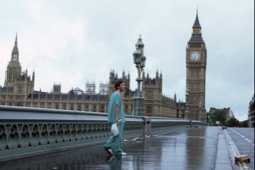

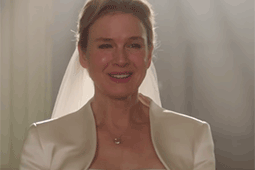
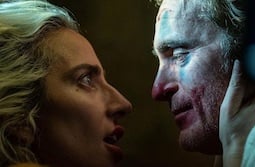

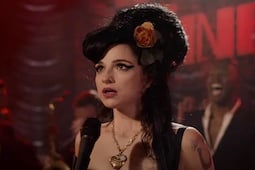
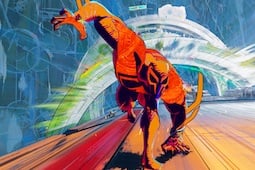
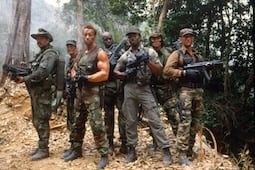


.jpg)
.jpg)

.jpg)
.png)



